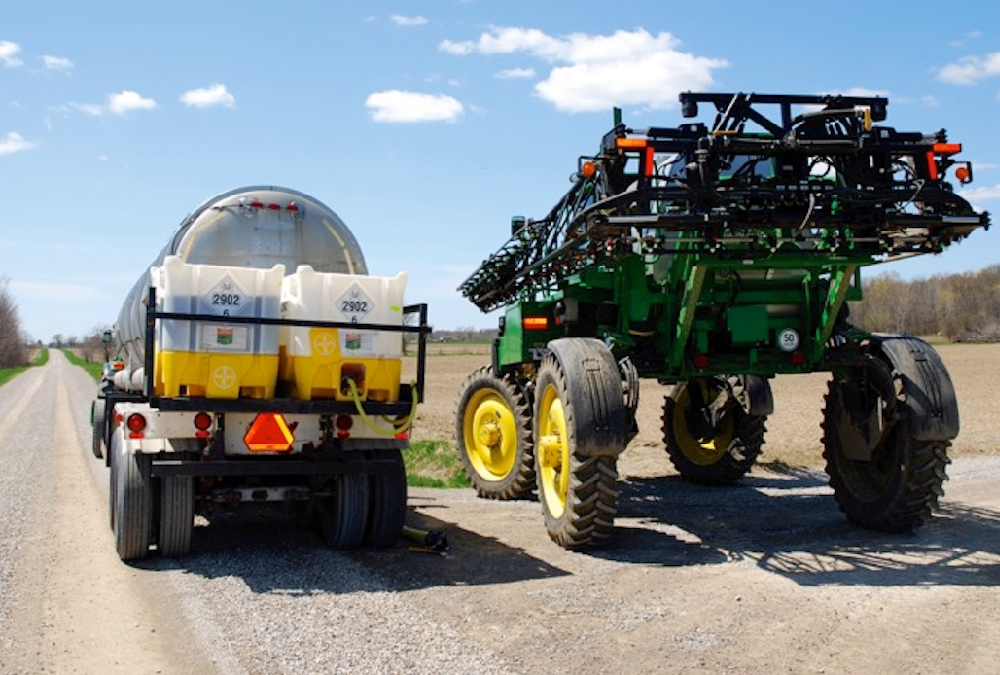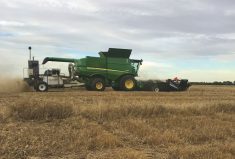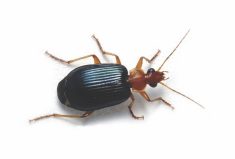Glacier FarmMedia – Sometimes the simplest solutions are the best ones.
Breanne Tidemann, an Alberta-based researcher with Agriculture and Agri-Food Canada (AAFC), says boots on the ground remains one of the most effective strategies when it comes to weed control.
“Don’t rely, especially in the spring, on the 80-kilometre-per-hour drive-by. Get out and get those boots on the ground,” says Tidemann, a weed management specialist who works at AAFC’s Lacombe Research and Development Centre.
Read Also

Producers aren’t panicking over tariffs and trade threats
The influence of tariff and trade uncertainity on farm business decisions.
“With something like cleavers, it’s notorious for popping up in the spring and being a purplish-brown colour. You’re not going to see that greening up as you drive by, but there could be a lot of cleavers already up and growing. Get out and get boots on the ground … to see what’s truly there. You really need to be tailoring the pre-harvest and post-harvest management decisions to what’s there (in the field).”
Kim Brown-Livingston, a provincial weeds specialist with Manitoba Agriculture, agrees. She says that’s especially true when it comes to evaluating the effectiveness of any kind of in-crop spraying.
“We need to do that post-spray scouting to see if we were successful. Did we miss something? Did anything get away on us? Did some of those perennial weeds start to regrow after an in-crop spray?” she says.
“It’s always important to follow up after any herbicide treatment. You need to be coming back to see how successful you were. You don’t want to waste a herbicide pass. You have to be successful with the herbicides you pick because with growing resistance we can’t be spraying herbicides and (them) not working because that weed is not on the list of weeds it controls.”
Battle plan followup
Brown-Livingston says having the right battle plan is a critical part of weed control, but following up on that plan is just as important. In some cases, she says, that could mean learning that a second in-crop herbicide isn’t required, which not only saves time and money but also saves that herbicide use for later.
Still, Brown-Livingston says a weed control plan should be adaptable since circumstances in the field can change quickly.
“You can have a battle plan, but you have to be able to adapt and adjust because things change all the time. That’s Mother Nature,” she cautions. “That’s why it’s really important to have that relationship with your agronomist and your retailer. Sometimes things change on the fly. That happened last year when some (fields) were too wet to get into to seed, so seeding plans had to change. You have to be able to adapt.”
Record keeping
Glyphosate resistance is a growing problem for farmers in Western Canada and elsewhere. As a result, many are now relying on an increasingly intricate blend of products in their tanks for both pre- and post-harvest weed control.
Brown-Livingston says because of this trend, it has become even more important for farmers to keep accurate and detailed records of what herbicides are being used in these mixes.
“We’re doing more tank mixes. We’re rotating through our herbicide groups more frequently. We’re putting a lot more and different products on the same field every year,” she explains.
“That’s great from a herbicide resistance standpoint, but we’ve got to do some really good record keeping then. When we’re looking at growing sensitive crops in that rotation, it’s important to have good record keeping, especially as things get a little more complex and we’re spraying more products in the field more often. It’s becoming crucial as we see more and more herbicides in those mixes.”
Sizing up the problem
Another suggestion Tidemann has for effective pre-harvest weed control is to size up any potential issue accurately. For example, where there is a well-defined patch of weeds, consider the potential effects of combining that section.
“What are you doing to that patch of weeds if you take the combine through it? Chances are you’re going to be spreading it. And chances are, if you have a very defined patch, there’s something about that patch that’s giving it a competitive advantage, whether that’s resistance or late emergence. Those are probably not weed seeds we want to be spreading around the field and making (the problem) bigger,” she says.
“If you have a kochia patch that is solid kochia and really not much grain in there, is it really worth taking that combine through it? Maybe that area should be mowed down. That’s something I highly recommend thinking about. Take the time (to think) about where your weeds are and what you are doing to them if you go through them with a combine.”
Electric weeders are among the more recent innovations in weed control. First, a product is sprayed onto the weeds to increase conductivity followed by an electrical charge to electrocute the weeds. Tidemann says while preliminary results have been promising, timing is important when using the device. It should be used before seed heads mature.
“The idea is not to hit (the weed) when those seeds are fully formed because at that point you’ve already missed that opportunity,” she says. “We don’t know yet if an electrical weeder affects seed viability. We know they can stop weeds from forming, but there’s less work done on the viability of mature seeds hit with an electrical weeder.”
Water quality
As herbicide mixtures have become more complex, the one constant has been good old H20. That’s why it’s important producers take note of the quality of water they are using in those mixes, says Clark Brenzil, a provincial weed control specialist with the Saskatchewan Ministry of Agriculture.
“With glyphosate being a little bit dodgy as far as supply goes and prices being a little higher, you want to get every bit of efficacy out of that application. A good thing to do is to check your water quality (going into the tank),” he explains.
“It’s not about whether the water is clear or murky. What you are looking for is which positively charged ions make up any salts in your spray water because calcium, magnesium, iron and manganese, to some degree, will antagonize glyphosate activity. You want to make sure if you have salts with those ions at a relatively high level, you are counteracting that with ammonium sulfate.
“When glyphosate was relatively cheap, it wasn’t as big of a deal because people would put in a little more glyphosate and that would be fine — it would take care of the problem. But when you are trying to shave the glyphosate rate as close to the (lowest) rate possible, you have to have good water quality,” he adds.
Brenzil suggests growers have water sampled at a local lab that will conduct a broad spectrum ion evaluation, which is also called a hardness test.
Some farmers use a reverse osmosis system to improve water quality. It employs a semi-permeable membrane to remove unwanted dissolved materials. Brenzil says capacity and cost are the most important considerations when determining whether the system is a good fit for a farm operation.
Post-harvest weed control
Timing is an important consideration for post-harvest weed control. That’s especially true with some perennial weeds like Canada thistle because they require four to six weeks to regrow and be big enough to hit with a post-harvest application, Brenzil says. This can make things difficult in areas that receive an early snowfall, he adds.
“There’s lots of unpredictability when you have post-harvest weed control.”
Brenzil also suggests growers consider the effect lower temperatures can have on the efficacy of some products when used as part of a post-harvest weed control strategy.
“(Cooler temperatures) will limit the activity of some of the more systemic products like glyphosate and Group 2s. In that kind of a situation, you are looking at trying to keep your applications to late September at the latest. Beyond that it starts getting pretty dodgy for overnight temperatures,” he says.
Brown-Livingston says tillage might become a more popular post-harvest weed control option in parts of the Prairies. It involves stimulating weed germination with light tillage and then destroying those weeds.
“We’ve come off of some dry years (in parts of the Prairies) where we didn’t want to do any of that tillage in the fall because we didn’t want to waste any soil moisture,” she says. “We seem to be in a … wetter cycle now, so that makes tillage much more attractive from a weed control standpoint. We’re not as worried about losing that precious soil moisture like we are in dry years.”
Tidemann urges growers to make sure they use a systemic herbicide product as part of their post-harvest weed strategy that will kill the entire plant by spreading though its vascular system.
“You really want to make sure that systemic product gets down into the weed’s roots like the root system of Canada thistle or something like that,” she says.
Walk the walk
Tidemann says it’s important to remember that pre- and post-harvest weed management isn’t just about herbicide application. There are other options growers can consider and they shouldn’t be afraid to “think outside the box,” she adds.
However, the best strategy to inform management decisions continues to be boots on the ground.
“We need to do more scouting,” Brown-Livingston explains.
“In the past we were able to get away without having to do that. But times are changing, and we have to make sure we’re doing a lot more boots-on-the-ground scouting, and making sure we know what we’re up against and pick the right products. We have to make sure these products work as best they can. A huge part of that is knowing what our weeds are and what we’re up against.”
– This article was originally published at Grainews.















